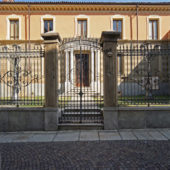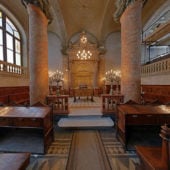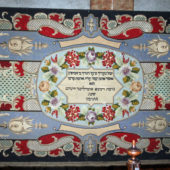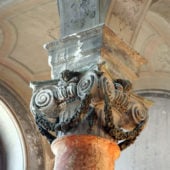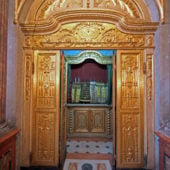Jews of Asti practiced a distinctive style of worship known as the Appam rite.
Though originally constructed in 1786, the Asti Synagogue underwent extensive remodeling in 1889. Interestingly, the work was intended to make the synagogue look like a Roman Catholic church, though how successfully the building’s almost residential, neoclassical exterior accomplishes this feat is open to debate. While the synagogue’s exterior may have been superficially disguised as a church, the interior, with its rectangular floor plan, captures elements distinct to Jewish worship and life in the Piedmont province of Italy.
Four massive, faux marble columns, topped with Corinthian capitals, support a central dome. The bimah in the synagogue, from which the cantor spoke originally, was situated in the center of the building for better acoustics – a common trait in Piedmontese synagogues. Some suggest that synagogue designers were here influenced by their Christian contemporaries, in particular by famed rococo stylist Bernini, because the four columned, centrally located bimah calls to mind Bernini’s baldachin over the altar in St. Peter’s Basilica in Rome.
After the synagogue’s remodel, the raised platform was moved toward the back of the room, closer to the ark. The floor space where the bimah was once located is now covered with rows of wooden benches.
The iconography found the Asti Synagogue also shares much in common with other Piedmontese synagogues due to its emphasis on portraying holy objects from the Temple in Jerusalem. These images may include the Tablets of the Law, Aaron’s staff, the Shewbread table and others. This is most evident in the doors of the ark, which were elaborately carved and gilded in 1809. These masterful carvings are true highlight of synagogue.
The ark, which today still contains torah scrolls, also is framed by fluted columns crowned with ornate capitals. A reproduction of Moses’ tablets sits at the very top of ark.
Jews had been a part of Asti since the 900s CE, enduring alternating periods of repression and relative freedom. Catholic popes sometimes protected and promoted the Jews while at other times they introduced repressive measures including identification badges or clothing and restricting occupational choices. Asti’s Jews enjoyed a breath of freedom when Napoleon invaded Piedmont not many years after the synagogue was constructed. During this period, Jews were declared equal citizens. However, with Napoleon’s defeat, this period came to an end until Italy’s King Carlo Alberto granted full emancipation in 1848.
Jews in Asti as well as Fossano and Montcalvo also practiced a distinctive style of worship known as the Appam rite. The rite, over 600 years old, combines ancient Ashkenazi, French and Provencal religious customs. The main differences include ceremonies on the Day of Atonement and in the music.

